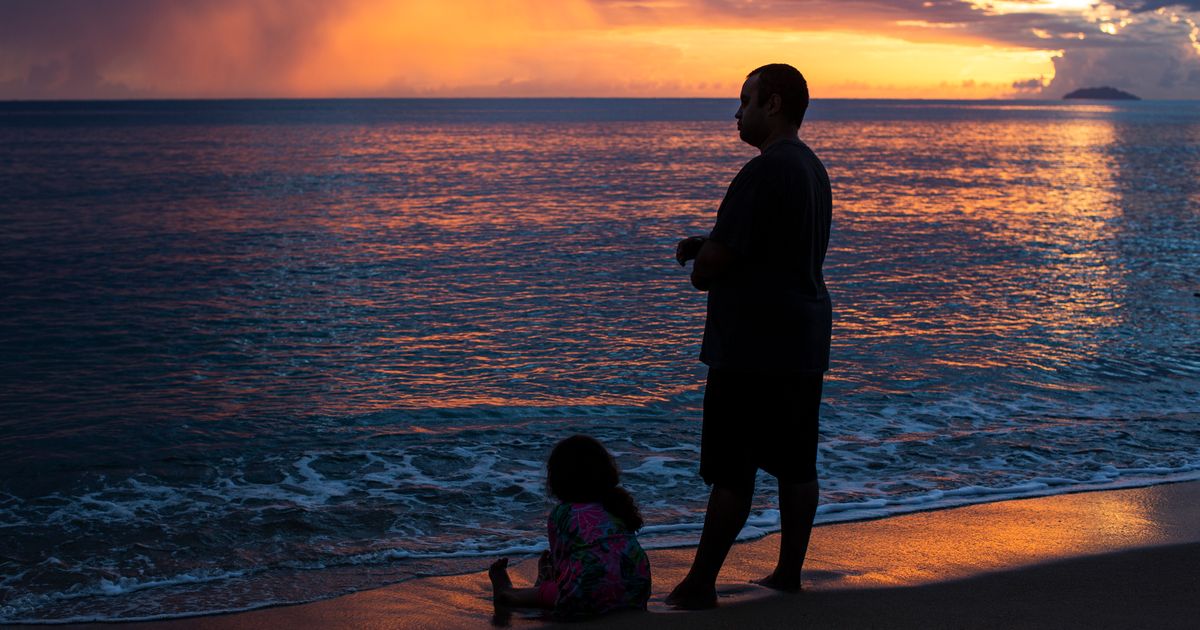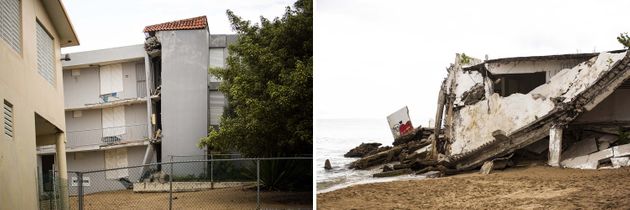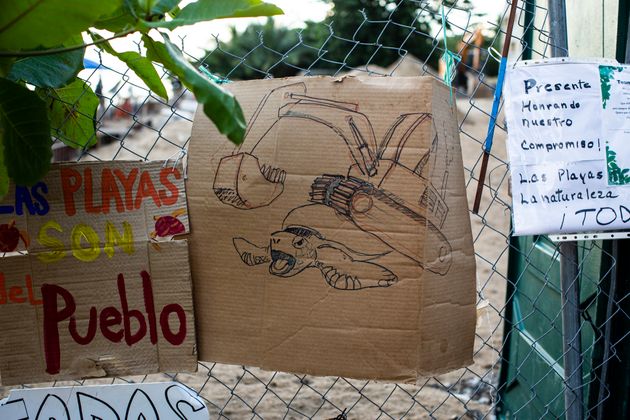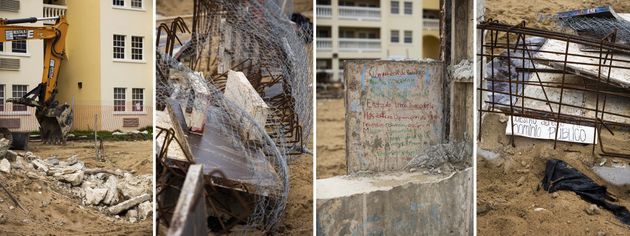The Battle Over The Last Piece Of Puerto Rico That Wasn’t For Sale
[ad_1]
Erika P. Rodriguez for HuffPost
RINCÓN, Puerto Rico ― To the west, a giant flaming peach of a sun sank into the horizon. Warm Caribbean waves lapped on the soft sandy shoreline where pregnant turtles drag themselves from the water each season to lay their eggs among mangroves and coconut palms.
To the east, cloistered behind a garrison of plastic orange barricades, dozens of heavily armed police officers paced and revved motorcycle engines, standing guard over gray concrete and construction materials.
Between the two, on a stretch of Los Almendros beach this August evening, is a small village of tents flying the black Puerto Rican flag of resistance.
“This is a war zone,” Miriam Juan Rivera said, shooting a steely glare at the police.
Erika P. Rodriguez for HuffPost
What began this spring as a local protest over the construction of a private pool on a public beach where endangered reptiles nest had, by the end of summer, evolved into a symbolic battle over the future of this island’s treasured waterfronts.
For years, virtually everything in Puerto Rico, from the nature preserves to the power utility, had been for sale as the deeply indebted U.S.-owned archipelago struggles to pay back billions of dollars to Wall Street. The beaches ― public access to which is guaranteed under Puerto Rican law ― had long been the exception. But as the local government seeks to remake the island into a hub for mainlanders seeking to avoid taxes, it is finding new and creative ways to claim the waterfront.
It’s happening all over the territory. On Vieques, the tiny island off Puerto Rico’s main island, locals who once took on the U.S. Navy and won are now struggling in “a vicious fight for access to the island,” according to a 2019 GlobalPost article, as Airbnb hosts build guesthouses on the beach. On the south coast, in Santa Isabel, the daughter of a former top government official is trying to build a hotel that would block access to a beach beloved by local kite surfers. In Dorado, just 30 minutes west of the capital city of San Juan, YouTube buffoon Logan Paul bought a beachside mansion earlier this year, bragged about flouting income taxes and proceeded to illegally drive a four-wheeler aroundin sand where turtles nest, declaring it his own.
Erika P. Rodriguez for HuffPost
But Rincón offered one of the starkest examples of how the government and wealthy interests have aligned to crush Puerto Ricans’ attempts to preserve ecologically and culturally vital beaches.
In late 2019, the board of directors at the luxury Condominios Sol Y Playa started laying plans to not only rebuild a pool destroyed during Hurricane María but expand it several feet onto the neighboring public beach. Sure enough, as environmentalists ― many of them retirees who live in this breezy seaside city ― started gathering at the beach to oppose the project, an army of police arrived in droves from departments as far as four hours away. Police boats patrolled waters where no one was swimming but the toddlers whose parents had come to protest. During one altercation in July, police in riot gear dragged an unarmed woman out by her hair.
Standing at the protest camp that formed on the beach, Ruperto Chaparro, director of the University of Puerto Rico’s Sea Grant program, said crushing the demonstrations would send a signal to wealthy Americans considering relocating to Puerto Rico that buying waterfront property here can, in fact, include a piece of Caribbean coastline devoid of actual Puerto Ricans.
“My theory is that this is a marketing tool to tell them this can be a private beach,” said Chaparro, whose federally funded group specializes in balancing the ecological and economic needs of coastal areas. “This is ridiculous.”
Erika P. Rodriguez for HuffPost
‘This Is Not About A Pool’
The pool itself wasn’t the point. Putting aside reasonable queries as to why anyone needs a pool just feet from a shallow and quiet stretch of bathtub-warm Caribbean water, the Sol Y Playa condos had long had their own chlorinated swimming hole closer to the actual four-story complex. When Hurricane María lashed the coast with fierce winds and surging seas in 2017, the pool was destroyed. Instead of using the insurance money to rebuild what was previously there, the developers decided to go bigger, building out several feet into the beach itself.
The developers at Sol Y Playa did not respond to emailed questions.
It didn’t take long for word to get out once construction fences went up and backhoes started digging.
There were obvious questions. If the last pool couldn’t withstand María, why would an even bigger pool, closer to the water, survive? Given that scientists say hurricanes are only growing more frequent and destructive as the planet warms, was it even wise to build anything new in the areas nature was so wrathfully reclaiming? The leatherback and hawksbill turtles who nested here were already endangered, shouldn’t their survival trump a new pool? How did this project even get permitted?
Ángel Román, the environmental consultant the Sol Y Playa condos hired to assess the project, insisted that the construction met every permitting requirement and could withstand future hurricanes.
Erika P. Rodriguez for HuffPost
“We have been extremely responsible in having an environmentally sound project,” he told the local news site NotiCel.
Some condo owners at Sol Y Playa disagreed. Concerned over what he believed to be illegal construction, José Barea, 61, a lawyer who owns a unit in the complex, alerted local authorities.
“You’ve got to respect that boundary that belongs to the people of Puerto Rico, we have to respect our fellow Puerto Ricans,” Barea said. “We cannot take what doesn’t belong to us.”
On May 17, Eliezer Molina, a former gubernatorial candidate and activist with tens of thousands of followers on social media, showed up on Los Almendros beach and broadcast an eight-minute live video in which he showed the construction site and complained that something so blatantly out of step with the area’s ecological constraints could only be approved through corrupt dealings. The video went viral, racking up more than 281,000 views and 10,000 shares on Facebook as of October.
Erika P. Rodriguez for HuffPost
Three days later, the Department of Natural and Environmental Resources, known by its Spanish acronym DRNA, sent the developers a cease-and-desist letter, forcing the project to halt construction. But just hours later, DRNA chief Rafael Machargo claimed the first order was not clear and reversed course, allowing construction to continue.
At the start of July, the ecological toll of the project came into full view when a hawksbill turtle slid under the chain-link fence and laid 180 eggs. The turtle, listed by federal scientists as “endangered” and by the World Wildlife Foundation as “critically endangered,” remained trapped in the construction site until 7 a.m. the following morning, when a guard noticed her.
Molina’s accusations quickly gained steam with a corruption-weary public. Two years earlier, up to 1 million Puerto Ricans had protested for weeks after leaked text messages showed close associates of then-Gov. Ricardo Rosselló directing major public contracts to friends and allies and speaking boorishly about those killed in Hurricane María. With as much as one-third of the territory’s population protesting in the streets of the capital, Rosselló had resigned in disgrace.
The situation in Rincón didn’t have quite the same stakes, nor were there leaked internal communications directly linking current Gov. Pedro Pierluisi, Rosselló’s handpicked successor, to the swimming pool. But the circumstantial evidence was troubling, at least.
Erika P. Rodriguez for HuffPost
‘Certainly A Crime’
As the protests at Los Almendros grew, droves of police arrived, including officers from as far away as Ponce and Bayamón. In total, at least 534 officers stood guard at the construction site, collecting some $630,803 in overtime pay, according to the newspaper El Vocero.
That figure doesn’t include what was spent to transport, feed and barricade the police in a makeshift headquarters alongside the condo complex.
On an archipelago where, unless you live in a wealthy community, dialing 911 is no guarantee that the police will even arrive, protesters saw the presence of so many armored and armed police as a sign a simple pool had become a political priority of the elite.
Adding to that sense was the revelation that Walter Pierluisi Isern, the governor’s first cousin and former campaign political director, owned an apartment at Sol Y Playa.
“This is not about a pool, this is about higher decision-making,” said Gloria Cuevas, a retired art teacher who had spent every day protesting. “After María, the island was open, and everyone saw poverty and need, and that, for some people, was an opportunity.”
The governor, for his part, defended the police deployment, telling El Vocero that the government has to “allow protest when it happens, but whenever the right to life and property is violated, the police have to be there.”
But it was the protesters whose rights were most in jeopardy, according to the Puerto Rico chapter of the American Civil Liberties Union.
By August, there were so many officers gathered by the entrance to Los Almendros beach, a visiting reporter at first mistook the condos for a police headquarters. The officers, many masked and holding guns openly, eyed anyone who walked the roughly 10-foot-wide pathway from the road to the sand and stationed at least one officer at a time at the entrance, as if checking tickets. When not at the beach, police cruised the otherwise peaceful streets of Rincón in groups, sometimes with two squad cars or a trio of motorcycles halting busy traffic to make way for themselves.
“There was a young woman who was sitting in the public part of the beach and since she did not stop because she had the right to be there, they took her by the hair and dragged her,” said William Ramírez, the ACLU of Puerto Rico’s executive director. “That is certainly a crime.”
Erika P. Rodriguez for HuffPost
A Turning Point?
On Aug. 4, the governor’s planning board, a separate agency from the DRNA, voted unanimously to declare the pool illegal, yanking its permits.
On Los Almendros, the news literally reverberated. The protesters danced and cheered, and those with instruments began playing music. At least a dozen people dove into the water to swim as a small burst of rain clouds dissipated and the sun emerged.
In San Juan, critics of the government started looking for who was responsible. The ACLU filed a complaint with the federal government requesting an investigation into police brutality against protesters. Last month, the Puerto Rican House of Representatives issued a report accusing Machargo, the DNRA chief, of intimidating witnesses and refusing to turn over public documents related to the Rincón pool project. The island’s Senate then voted overwhelmingly to order Machargo to answer questions before a hearing.
Advocates, meanwhile, demanded Pierluisi fire Machargo.
Machargo said the investigation into him had “neither head nor tail” and accused the legislature of “interfering” with the conduct of his executive branch agency, something he said would “create a disastrous precedent.”
“We did everything possible to safeguard the process,” Machargo said.
A spokesperson for DNRA did not respond to a request for comment. The governor’s office did not return two calls requesting comment.
Judith Enck, the former regional Environmental Protection Agency administrator for Puerto Rico under the Obama administration, said federal regulators have little power over land-use decisions in the territory, meaning the buck tends to stop with the sitting governor.
Erika P. Rodriguez for HuffPost
“Puerto Rico should have learned the lesson of the need for climate change resiliency, and a central part of that is not constructing things along shorelines,” she said. “The Puerto Rican government should know better.”
During the Trump administration, when the White House repeatedly dismissed the concerns of Puerto Ricans and halted money Congress authorized to rebuild the territory, federal agencies had little leeway.
“But that money is flowing now,” Enck said. “So there’s a need for stronger federal oversight.”
Attention from Capitol Hill has helped elsewhere. At a hearing on federal climate funding for U.S. territories last February, Rep. Jesús “Chuy” Garcia (D-Ill.) pressed Machargo about the plans to build a hotel in another Puerto Rican municipality, Santa Isabel, that would cut off the community’s access to the beach. Machargo seemed flustered.
“According to the law of the government of Puerto Rico, everybody should have access to the beach. That would be illegal to cut people from access to the beach,” Machargo told the congressman. “I will take note of that case and I will look into it to see if they have all the permits.”
Eierí Ossorio, 40, an avid kitesurfer who grew up near the proposed hotel in Santa Isabel, credited local organizing for upending the proposed development in his town. But he said the federal scrutiny helped.
“It’s been almost a year,” he said. “And they haven’t built a hotel anywhere.”
Erika P. Rodriguez for HuffPost
In Rincón, the construction equipment has idled and most of the police have left. But the partially dug pool remains as the condo board fights in court to have the permits reinstated. Some protesters have remained on the beach, keeping watch. Barea, who began receiving routine threats to his family after he publicly opposed the project, said he has not returned to his unit at Sol Y Playa since June.
The coastline is already dotted with new buildings. But some hope the issue could mark a turning point in the fight to keep Puerto Rico’s beaches open.
“This is where people can go for fun for free, so, by doing this, they are increasing our vulnerability and reducing our resiliency when we have climate change,” Chaparro, the Sea Grant director, said. “We should be taking climate change seriously in our development plans.”
Yet, in Puerto Rico, disregard for ecological boundaries is the longstanding norm. Back in 1997, DNRA surveyors had determined that the protections for Los Almendros beach weren’t sufficient, according to a recently resurfaced report. Despite that finding, construction crews broke ground the next year on a luxury development. Its name? Sol Y Playa.
[ad_2]
Original Post















Terrific post but I was wanting to know if you could write a litte more on this subject? I’d be very grateful if you could elaborate a little bit further. Kudos!
Hello, i feel that i noticed you visited my web site so i came to “return the favor”.I am trying to in finding issues to improve my website!I suppose its ok to use a few of your concepts!!
Your style is so unique compared to many other people. Thank you for publishing when you have the opportunity,Guess I will just make this bookmarked.2
I appreciate, cause I found just what I was looking for. You’ve ended my 4 day long hunt! God Bless you man. Have a nice day. Bye
Perfect work you have done, this internet site is really cool with good info .
Hello just wanted to give you a quick heads up. The text in your post seem to be running off the screen in Opera. I’m not sure if this is a format issue or something to do with browser compatibility but I figured I’d post to let you know. The style and design look great though! Hope you get the issue fixed soon. Many thanks
Hello would you mind letting me know which hosting company you’re working with? I’ve loaded your blog in 3 completely different web browsers and I must say this blog loads a lot quicker then most. Can you suggest a good hosting provider at a fair price? Many thanks, I appreciate it!
I really enjoy reading through on this website, it contains wonderful posts. “Never fight an inanimate object.” by P. J. O’Rourke.
Do you have a spam problem on this blog; I also am a blogger, and I was wanting to know your situation; we have created some nice practices and we are looking to exchange methods with other folks, please shoot me an email if interested.
Hi, Neat post. There is a problem with your site in internet explorer, would check this… IE still is the market leader and a large portion of people will miss your great writing due to this problem.